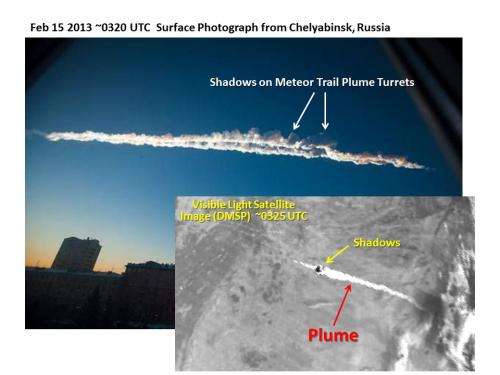Scientists identify visible, infrared imagery left by meteor across Russia

Visible and infrared imagery of the meteor that made a fiery entry into the Earth's atmosphere over the Ural Mountains of Russia has been captured by Colorado State University scientists.
Steve Miller, deputy director of the Cooperative Institute for Research in the Atmosphere (CIRA), a partnership with NOAA, analyzed imagery from the Defense Meteorological Satellite Program (DMSP) weather satellite and captured several images of the condensation trail left behind the meteor as it entered the Earth's atmosphere at an estimated 33,000 mph (54,000 km/h.)
The meteor, which scientists estimate to have been roughly 15 meters across and with a mass of 10-11 tons, has caused widespread damage and 1,000 injuries across the Chelyabinsk region, approximately 900 miles east of Moscow.
"We were extremely lucky to have a satellite crossing the immediate area, literally moments after the event. The imagery can help us understand some details of the entry that may have been more difficult to infer from the surface observations alone." Miller said.
CIRA researchers conduct cutting-edge research using a variety of satellite observations. CIRA was established as in interdisciplinary partnership between the National Oceanic and Atmospheric Administration and CSU in 1980.
Provided by Colorado State University




















